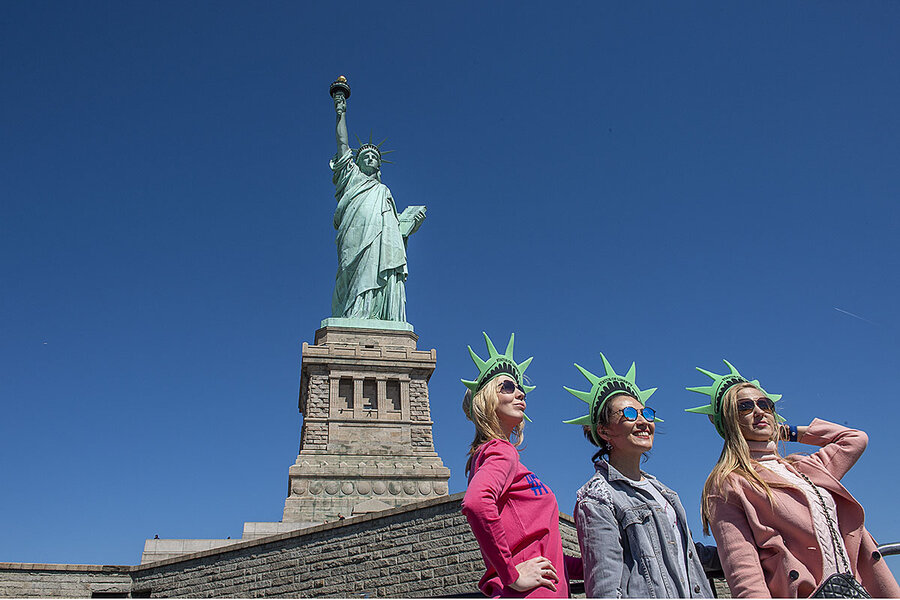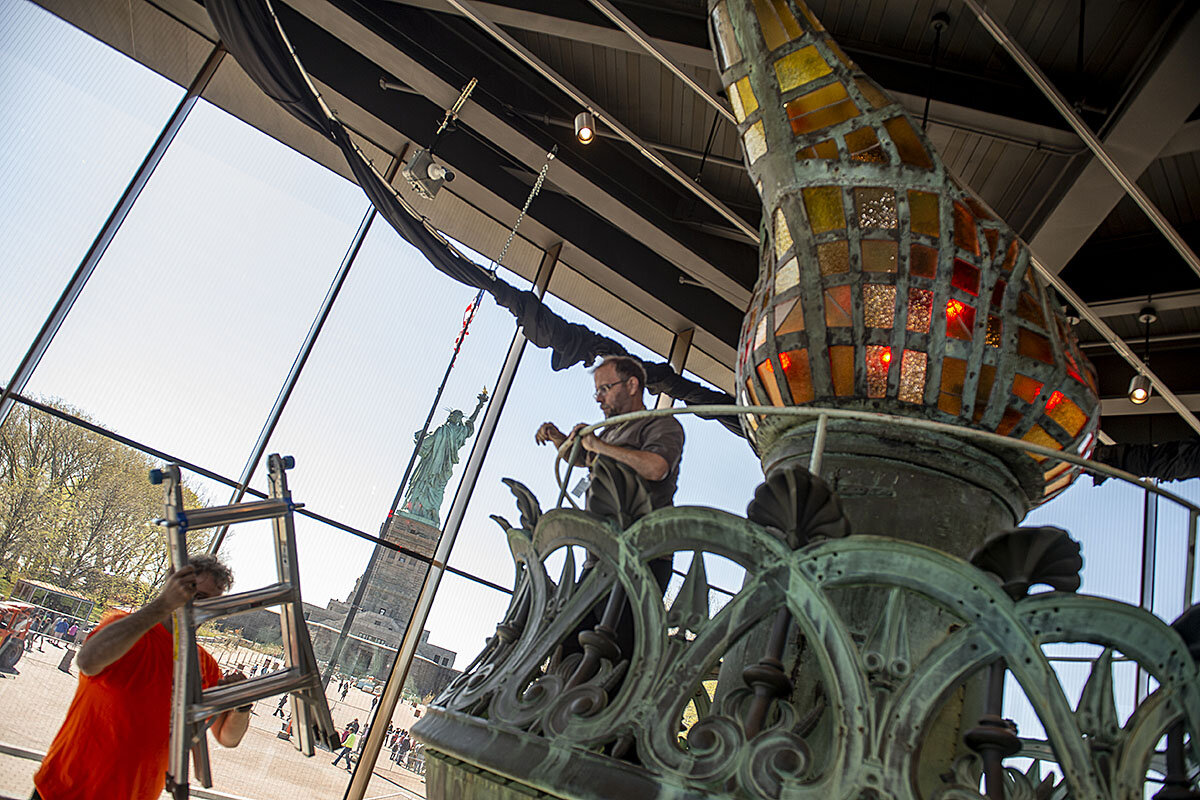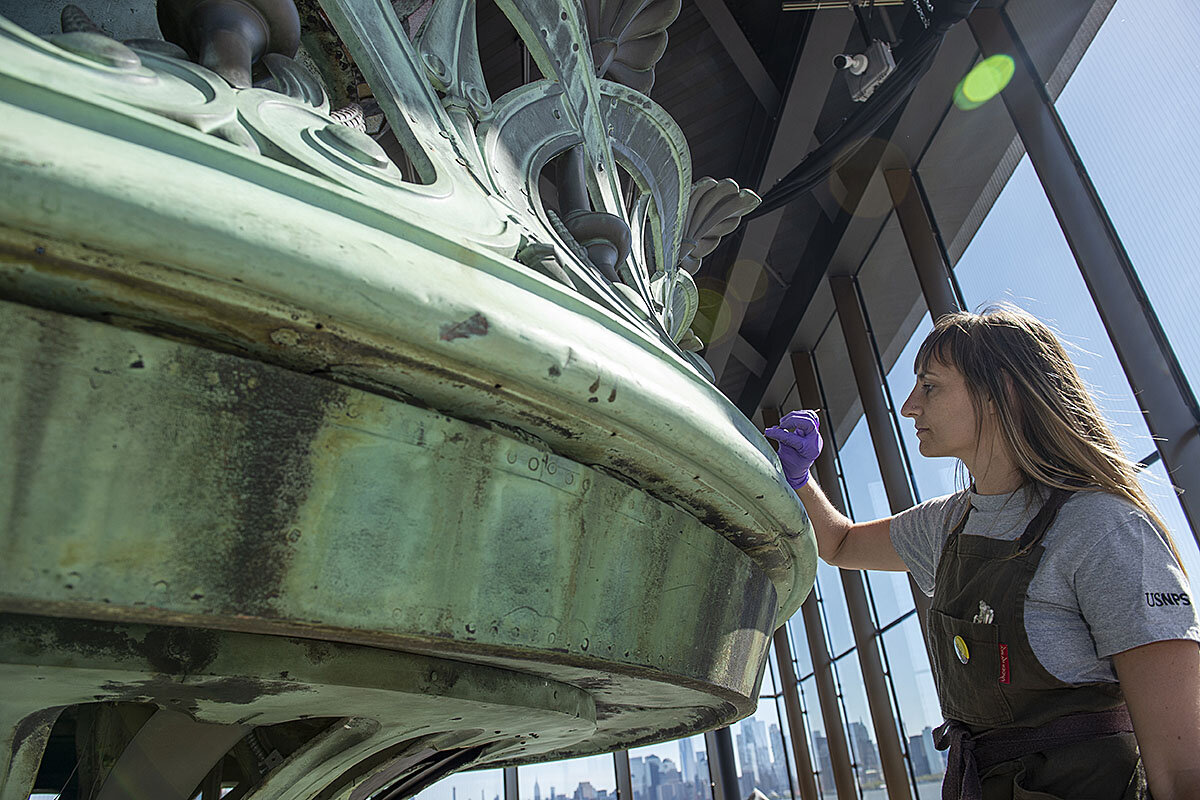What does Lady Liberty stand for? A look at changing attitudes.
Loading...
| New York
When Emily Webster and her colleagues were designing the new museum for the Statue of Liberty, the logistics of ferrying 4.5 million visitors a year over to an environmentally sensitive islet in New York Harbor was only part of the challenge they faced.
“With such an epically historic concept that the museum needed to represent, we couldn’t just be reverent and historical about the artifacts,” says Ms. Webster, head of media architecture at ESI Design in Manhattan. “In fact, we kind of also needed to really think about what the meaning of liberty is – that it’s a contested idea,” she says during a tour of the museum.
The Statue of Liberty Museum, a $100 million project that began to take shape after 9/11, opens Thursday. It’s an upgrade from a previous, much smaller collection of exhibits on Liberty Island, and in the new rendering, high-tech interactive exhibits take center stage. Their focus: “imagining” and “constructing” the meaning of liberty.
Why We Wrote This
Lady Liberty is getting a new museum at a time of heated debate on immigration. Revisiting the statue’s history offers fresh perspectives on what it stands for – and how that may have changed.
Ideas about Lady Liberty’s symbols have shifted over time, and today, they’ve become as pointed as her diadem.
“It was also really important to the project that people understand that liberty is sort of an active process,” Ms. Webster says. “You can’t just sit back and expect it to be maintained.”
Conceived as a symbol of Enlightenment liberalism, the statue was a gift from France, dedicated in 1886 to celebrate both nations’ republican ideals, including the abolition of slavery. Later it would be associated with the military, a patriotic symbol used to sell war bonds – and was an inspiration to service members returning from war.
Even so, the Statue of Liberty has long been closely associated with a specific meaning, and a specific period in American history: the era around the turn of the 20th century, when millions of immigrants were sailing every year into New York Harbor – “your tired, your poor,/ Your huddled masses yearning to breathe free,” to quote Emma Lazarus’ poem. The immigrants’ first dramatic encounter with their new world was the 305-foot “new colossus” and the inspiring way she held her torch to the sky.
Influencing global politics
But in both the United States and other Western nations, issues surrounding the plight of refugees and other foreign migrants have been reshaping global politics, if not the self-identities of the world’s liberal democracies. And some observers say this traditional idea of the Statue of Liberty, as a beacon for poor immigrants, is indeed a contested idea.
“What Americans remember is a myth created in its own day, the poem inscribed on the base written by Emma Lazarus, a German-Jewish New Yorker who wanted to raise money and awareness for the plight of Jews in Europe, especially in czarist Russia, where bloody purges were commonplace,” says John Seung-Ho Baick, professor of history at Western New England University in Springfield, Massachusetts.
“She was seeking to redefine the statue from an abstract Franco-American symbol into something far more specific, into a symbol of opportunity and hope for the oppressed people of the world,” Professor Baick says. “The American colossus was not the Colossus of Rhodes, meant to awe and intimidate. She was meant to be the beacon to the lost and hopeless, a mother who welcomes all as her children.”
But the symbols of the Statue of Liberty weren’t thought of that way at first, others say, noting how the statue originally was meant to reflect the shared ideals of republicanism and Enlightenment liberalism, as they were imagined in the late 19th century.
“These ideals would have been more generally geared towards ideals of freedom in religion, speech, trade, and self-determination; anti-authoritarianism in general would also have been a prominent theme,” says Ryan McMaken, an economist and immigration expert at the Mises Institute, a libertarian think tank in Auburn, Alabama.
French artists and others in the 19th century had already been using the classical image of the Roman goddess Libertas to represent the age of revolution and the principles of liberalism. And when French thinkers conceived of the statue as a gift to commemorate the centennial of the American Revolution and the more recent abolition of slavery, its iconic torch symbolized what is still its official name: “The Statue of Liberty Enlightening the World.”
The sculpted broken chains at Lady Liberty’s bare feet – a lesser-known feature of the iconic statue – also symbolize how this new concept of liberty broke the authoritarian chains of church and monarchy.
But in some circles, the Statue of Liberty may not loom as large.
“For many of us who are descended from Mexicans, for example, the Statue of Liberty plays no role in family histories or ideals expressed about aspiring to join the American mainstream,” says Mr. McMaken, whose maternal grandparents immigrated from Chihuahua, Mexico, to El Paso, Texas, around 1915.
“While New York certainly continues to be a popular place of arrival for immigrants, the southern border of the U.S. is at least as central now in the experiences of migrants to the U.S.,” he continues. “The American borderlands in the West have a very different iconography than that often used by immigrants who arrived by boat in the northeastern United States.”
Rising skepticism
Also, after the First World War, the U.S. as a nation began to become skeptical of the waves of huddled masses entering the country. There was the rise of eugenics and racial theories teaching that peoples from the Mediterranean and Eastern Europe, including Jews, were “polluting” the Nordic stocks of northern Europe. Irish Catholics, too, many of the nation’s elites believed, posed a threat to the nation’s Anglo-Protestant heritage.
“That optimism about the capacity of the country to absorb and transform poor immigrants had tremendous power, but also had limits,” says Mark Naison, a professor of history and African American studies at Fordham University in New York. “It didn’t apply to Asian immigrants, whose arrival was sharply limited by Chinese Exclusion Acts passed in the late 19th and early 20th centuries. It also didn’t hold up to the wave of xenophobia that swept the country right after World War I, leading to legislation which sharply limited immigration from Southern and Eastern Europe and all non-European countries.”
The federal Immigration Act of 1924 set quotas for immigrants based on the 1890 census – a survey taken before immigrants were sailing into New York Harbor in waves. These restrictive quotas weren’t changed until 1965, when U.S. policy shifted to emphasize bringing in skilled workers and reuniting immigrant families – a “chain migration” that the Trump administration has been trying to eliminate.
“A myth like the Statue of Liberty can be more powerful than history, inspiring revolutionary change,” says Professor Baick at Western New England University. “Or it can become comforting, anodyne words that belie that the world sees America more and more like an ancient Greek colossus, imperious and terrifying. Does she stand beside the golden door? Or does she loom over a wall?”








